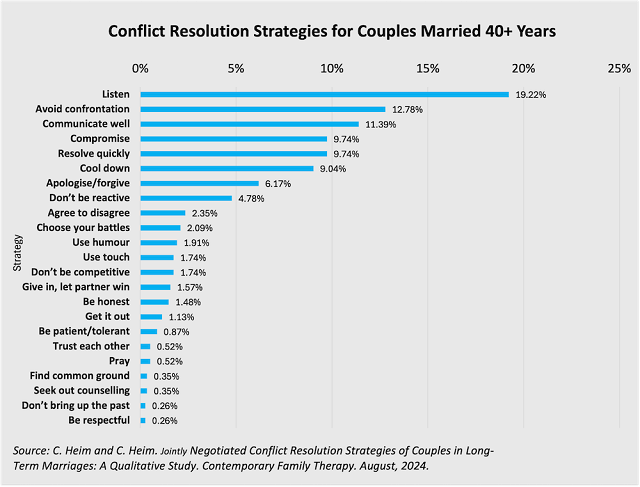Highlights
- Long-term couples jointly negotiate their own conflict resolution strategies over time to best suit their relationship. Post This
- In a new study of 1112 long-term coupled individuals, the top three conflict resolution strategies were: listening, avoiding confrontation, and communicating well. Post This
- In the context of a couple relationship, conflict is handled, managed, ameliorated, minimized, revisited, tolerated, or accepted. Post This
In a world of increasing conflict—where marriage rates are in sharp decline and technological change and social upheavals occur at unprecedented rates—perhaps we could be reminded of the benefits of a long-term life focus, specifically in marriage. One of the benefits of a long-lasting marriage, according to new research, is the development of skills in negotiating conflict. This is no small thing. Advocates for conflict resolution in the workplace, for example, now look to what can be learned about conflict resolution in couples.
Our recently published study has something to add. One important skill that married couples develop over time is the ability to Jointly Negotiate Conflict Resolution Strategies (JNCRS) to their mutual benefit. Previous studies in this area have looked at the conflict resolution styles that individuals bring into a marriage, and many studies have explored what goes wrong in marriages. Only a few small studies1 have looked at what goes right in marriages over the long-term in conflict resolution.
As part of the larger Resilient Relationships Study, we looked at the conflict resolution strategies of 1,112 coupled individuals born in 48 countries married 40+ years (average 50). We interviewed 180 individuals, and 932 responded to an online survey. This mixture allowed us to back up depth of information with breadth of information. Depth from interviewing, for example, clarified the difference between a conflict style and a conflict strategy:
Before we got married, I told her about my shortcomings, my past, my volatile temper. But now she is the calming factor in my life. She reminds me, ‘darling, darling, you’re losing your temper.’”
—Romeo and Lunesa, The Philippines, married 48 years
Having a “volatile temper” (as seen in a workplace) is a conflict style, which may have been inherited from or modelled by a parent. Her saying “darling, you’re losing your temper” as a reminder is a conflict resolution strategy (JNCRS) based on consideration of his underlying conflict style, her calm demeanour, and acceptance of her strengths and his “shortcomings.” It has been, as the couple explained, negotiated over their time together.
Through analysis of interviews and surveys, we identified 23 JNCRS that couples used:

The high number and wide range of strategies suggests that rather than looking to formulas or rules in conflict resolution, two unique people in a long-term union find unique solutions to suit their unique needs. In contrast, however, is that three strategies— listening, avoiding conflict, and communicating well—accounted for 43% of the strategies mentioned; and six—adding compromise, resolving it quickly, and cooling down—accounted for 72% of all the strategies mentioned. These six, then, could form the basis of some ‘tips’ or ‘guidelines’ in developing conflict resolution strategies.
What Works
That ‘listen’ is the most used JNCRS comes as no surprise. In line with ideas by Marshall Rosenberg in conflict resolution, really listening to each other thoroughly could create the goodwill needed to resolve conflict. More controversial, however, is avoidance as a highly favoured JNCRS. Traditionally seen as a dysfunctional strategy, many of these couples found it very useful, particularly when it meant why bother going into this again, we know each other’s views so well. Avoidance may forsake superficial gain to protect underlying attachment. Growing evidence attests to the adaptive nature of avoiding confrontation, even in the workplace.2
Communicating well is self-evidently useful, as is the ability to compromise, resolve conflict quickly, and to cool down from heated emotions before taking up the struggle of resolving conflict again. As one wife shared:
He used to be a raging inferno, which became very hurtful [but now he says] let’s take a walk.
—Carol and Steven, Australia, married 40 years
Couples, however, need not necessarily be good at any of these strategies; they may employ some other of the 23 strategies or use strategies not articulated here.
A term such as “Conflict Resolution Strategy” is a bit of a misnomer; evidence suggests that couple conflict tends to be ongoing with only rare resolutions. In the context of a couple relationship, conflict is handled, managed, ameliorated, minimized, revisited, tolerated, or accepted. This principle, too, can be applied to the workplace and other life areas.
The table below includes a categorization of the strategies under four main areas:

Categorizing these strategies further distinguishes them from identified conflict styles, such as avoiding, withdrawing, complying, or positive problem-solving. Our research privileges the 1112 coupled individuals here as quasi-relationship experts, as together they have over 55,000 years of relationship experience.
These JNCRS, as our study shows, evolved over time as two people aimed to live in harmony. Other times they developed, changed, were refined, and were tried and tested over many years. This, too, holds a key to conflict resolution in other life areas: the idea that continuing relationship and knowing each other is important.
Conflict, as stated, is ubiquitous in the human condition. It ranges from intra-psychic conflict in each individual’s competing wants and desires, couples wanting to live in two-person harmony, corporations balancing assertive dominance and co-operative reciprocity, to a world of conflicting agendas, motivations and perceptions. Couples able to jointly negotiate conflict resolution strategies to stay in relationship over 40 years have valued wisdom to impart, such as the following from our study: “conflict is a part of life, it is teamwork. We’ve learned over the years what not to do […] now we walk through it together” (Monte and Janeen, USA, married 45 years).
Christian Heim is a clinical psychiatrist and senior lecturer at The University of Queensland, and Caroline Heim is an Associate Professor at Queensland University of Technology in Australia.
1. Barman, J. D., Maheshwari, S., & Varma, P. (2022). The Conflicts and Conflict Management in Stable Middle-Class Marriages: An Indian Perspective. The Family Journal (Alexandria, Va.). See also: Mackey, R. A., Diemer, M. A., & O’Brien, B. A. (2000). Conflict-management styles of spouses in lasting marriages. Psychotherapy (Chicago, Ill.), 37(2), 134–148.
2. See: Roloff, M. E., & Ifert, D. E. (2000). Conflict management through avoidance: Withholding complaints, suppressing arguments, and declaring topics taboo. In S. Petronio (Ed.), Balancing the secrets of private disclosures (pp. 151–163). Lawrence Erlbaum Associates Publishers; Liu, E., & Roloff, M. E. (2016). Regret for Complaint Withholding. Communication Quarterly, 64(1), 72–92. Also: Ohbuchi, K. I., & Atsumi, E. (2010). Avoidance brings Japanese employees what they care about in conflict management: Its functionality and “good member” image. Negotiation and Conflict Management Research, 3(2), 117-129. And see: Van Erp, K. J. P. M., Giebels, E., van der Zee, K. I., & van Duijn, M. A. J. (2011). Let it be: expatriate couples’ adjustment and the upside of avoiding conflicts. Anxiety, Stress, and Coping, 24(5), 539–560.










